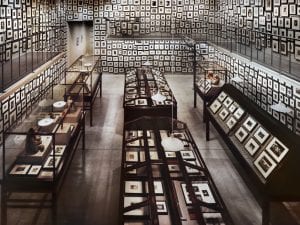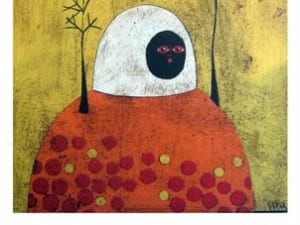The Royal Academy’s winter 2010 exhibition surveyed the changing role of fashion within the context of wider identity formation.
Considering the standardisation of the human form, the variety and complexity of the ways in which we choose to cover and embellish it is astonishing. For centuries groups and tribes have used their fashions and costumes, not only to clothe, provide modesty and protect, but to hide or project an image of themselves to the world, in a manner more expressive, and more universal than would usually be considered in a gallery setting. From the elaborate powdered dress of the 18th century macaronis, to the sweeping flower power dresses of 1960s hippies, and the bondage trousers of 1970s punks, clothing has been used as a mechanism to align ourselves to certain beliefs, to communicate our allegiance and identity to the outside world. As we see the permutations of fashion, design, fine art and craft increasingly intertwined there is a new connection and recognition for artists of the power of dress, an ability of clothing to reflect on the sociological conditions around us and to examine our issues of concern.
Aware: Art Fashion Identity addresses these under-explored areas of fashion at the Royal Academy for the first time as the latest season of GSK Contemporary, incorporating works from designers and artists practicing at the forefront of identity exploration, including Maria Abramović, Hussein Chalayan, Yoko Ono, Grayson Perry, Gillian Wearing and Yohji Yamamoto as well as lesser-known artists such as Dai Rees, Claudia Losi and Alicia Framis. Now in its third year, the unlikely collaboration between pharmaceutical company GlaxoSmithKlein, and the Royal Academy has enjoyed unbridled success, with previous offerings looking at the relationship between contemporary art and theatre, and contemporary artists’ responses to climate change, and now a timely interrogation into the uses of fashion in art. Royal Academy curator, Edith Devaney, explains that the collaboration has “enabled us to be ambitious in our thinking regarding the showing of contemporary art” and given “us the freedom to push the boundaries of our thinking in looking at the reach of contemporary art.” The GSK Contemporary seasons aim to bring contemporary art to an even wider audience following its explosion in popularity over the last 10 years, and the collaborations between art and fashion only serve to emphasise the heightened accessibility of contemporary art today.
Aware: Art Fashion Identity is separated to interrogate four separate uses of clothing and dress – Storytelling, Building, Belonging and Confronting, and Performance. Storytelling acknowledges the role of clothing in the representation of personal and social history, Building explores clothing as a form of protective covering and the creation of safe havens through our dress, while Belonging and Confronting examines ideas of nationality by recognising the tensions implicit in the assimilation of new cultures and traditions. Finally, Performance highlights the role-play of daily life as well as the role of performance and spectacle in fashion itself.
Most commonly approached in costume retrospectives is the concept of fashion as a way of forming an identity from one’s past, and one’s associates, and the Storytelling element engages strongly with this. Grayson Perry’s Artist’s Robe (2004) quite literally tells a story through the medium of clothing, the robe inspired by Japanese kimonos and embellished in Perry’s meticulous appliqué with motifs referencing the role of the artist in society today. With a particular focus on being watched, studied and interrogated Perry’s contribution is interesting in contrast to his later works satirising the society around him because Artist’s Robe interrogates his own identity rather than that of others.
Conversely, Gillian Wearing’s 1996 piece, Sixty Minute Silence, presents a personalisation of the facelessness that often accompanies the wearing of official uniform. Wearing’s work positions 26 police officers for a formal shoot for which they must pose for 60 minutes. As we see the officers’s resolve for solemnity gradually disintegrate, the true personalities behind the familiar uniform are clarified. Simultaneously respectful of the grave work of the police force, and humorously highlighting the humanity of the “boys in blue”, Wearing’s work references the solidarity and individualism of the wearing of the uniform. It’s interesting to note that even unofficially, uniforms pervade our consciousness and the history of fashion – with those outside of the armed and civil forces still striving to maintain a solidarity. Thinking of the teenage subcultures of today; Goths, Skaters, Hoodies and Emos, all are expressing an allegiance to one group, as a mark of separation from the rest who are not within their chosen clique. Meschac Gaba’s Perruques-Architecture ( 2006) plays with the identity of clothing in a different way by applying traditional African hair braids to the motifs of modernist architecture. The hat-like structures emulate Western masterpieces such as the Empire State and Chrysler buildings in a conglomeration of the developed world and tribal societies, juxtaposing the usual gleaming metallic surfaces of the original buildings with the newly incorporated ethnicity of ruggedly worn braids, and a long history of hair cultivation throughout the African continent.
Fashion’s importance is particularly pertinent for the artists attuned to the social situations of our times. For example, in the Building component, Mella Jaarsma’s work, Shelter Me 1, (2005) defines shelter as the minimal construction needed for projection, and so in its minimalism it rejects the architectural forms of housing, to assume the organic form of the human body. Jaarsma questions the boundaries and necessity of shelter for the human form – it brings to our attention the plight of homeless people around the globe and yet questions our disposable society. Similarly to Victor Burgin’s 1978 poster proclaiming “What does possession mean to you? 7% of the population own 84% of the wealth”, the work gives the facts, and the opportunity and potential for change without passing judgment on the situation itself. Leaving us to decide, Shelter Me 1, is apt not only for drawing attention to the needy, but also in questioning our material culture. Jaarsma recognises the nomadic nature of many of our lives, how we so often reject our home towns and familiar comforts for the new and yet surround ourselves with huge swathes of disposable objects that bear no relation to our actual identity.
Similarly, Yoko Ono’s Cut Piece (1965), where the artist allowed the audience to cut strips from her clothing in New York’s Carnegie Recital Hall, examines the constructs of society and the social parameters that we naturally put in place in the very act of discarding them through the shedding of the artist’s clothing. As Ono’s naked form is revealed, the social construct of her clothes has precluded the breaking away of the usual rules of society. Ono is drawing attention to our own artifice and yet the performance itself is an artifice where Ono is playing a pre-determined role – that of the shocking contemporary artist that she cultivated for herself not only through her work, but through her controversial protests, high profile relationship, and continued ability to provoke well into her 70s. In doing away with the rules and regulations, and social comforts of fashion and clothing, Ono requests that we look at ourselves as nature intended, and question the very existence of these social norms and things that we think necessary in order to conduct a civil society.
Through technological innovations, Ono’s work is mirrored by artist and professor, Helen Storey’s work, Hello Goodbye (2010), whereby a dissolvable dress is displayed and diminished in a manner that presents a solution, rather than a critique, to the phenomenal wastage of contemporary society. Created after extensive research with Professor Tony Ryan, Storey’s pieces force the viewer to take stock in their vulnerability, yet are beautiful elaborate pieces by virtue, not only of their delicacy, but also of their pioneering nature.
In working the “foundation” artworks of the 1960s into the exhibition’s body, Aware: Art Fashion Identity engages in the continued narrative between contemporary artists and the projections of fashion and clothing. The early works contextualise the exhibition by providing grounding in clothing’s ability to create an identity. As the works involved display such a range of mediums and address a myriad of issues, it is difficult to determine a beginning and end because the works involved are so wide-ranging. The idea of an increasing crossover between art and fashion is nothing new, and the aims of the Royal Academy to bring fashion out of the commercial and into the realm of the artistic, while maintaining its populist appeal and approachability is clear.
Fashion is a hugely commercial enterprise, with vast amounts of money exchanged and invested at both high and low ends of the scale and it is questionable whether it can be freed from these commercial constraints in the same way as the products of fine art, through the work of public galleries, and the sponsorship of bodies such as GSK, have been released. The greater accessibility of clothing is in part because of this commercialism – because everybody must buy it; it’s seen as a business and a worthwhile investment. In spite of the aims of GSK Contemporary to bring contemporary art to a wider audience this accessibility was not the aim in choosing the exhibition. However, Devaney acknowledges: “The principal that clothing touches many more people than fine art is clearly demonstrated in artists’ appropriation of clothing as an effective vehicle for communicating artistic ideas due to its accessibility.”
In their exhibition statement the curators argue: “Aware will reflect upon the relationship between our physical covering and constructed personal environments, our individual and social identities and the contexts in which we live. As a mechanism of expression, the exploration of the role of clothing has been at the heart of the artistic practice of a number of contemporary artists, and has particular resonance for those attuned to the social situations of their times. Whilst frequently fulfilling a practical and occasionally protective function, clothing can be effective in celebrating or suppressing identity and in indicating allegiances. It has the ability to express our way of life and even our unconscious, communicating our positions, aspirations and desires. At times however, the exhibition theme is vague, even tenuous, but Aware: Art Fashion Identity promises to be a crowd pleaser by virtue of the huge names, and exceptional variety included in its remit.
Conceived by Gabi Scardi with artist, Lucy Orta, then curated alongside Royal Academy curators Kathleen Soriano and Edith Devaney, Aware: Art Fashion Identity has a strong range of curatorial voices. However, the idea of the connections between each section is unclear and there’s an inevitable cross-over between elements that could have been more coherently collected through the use of less rigid definitions between each aspect.
With fashion’s thirst for the new, it is inevitable that the most exciting aspect is the specially commissioned works from Yinka Shonibare and Hussein Chalayan, each representing the longevity of the relationship between art, fashion and identity through its engagement with centuries old theatrical and Japanese traditions – Chalayan’s dress is inspired by 300-year-old Bunraku puppet theatre, while Chris Stevens will create 18 designs based on 19th century children’s dress to be displayed two-dimensionally on the wall. There’s a danger of monotony with fashion exhibitions particularly in terms of curation, but the interpretation of the theme to include such wall-displayed works and performance promises to keep a fresh perspective on a challenging theme. It is possible that the remit of Aware: Art Fashion Identity is too broad and ambitious in its scope, but in raising the questions of these three facets, it provides a promising starting point for future works to come.
GSK Contemporary – Aware: Art Fashion Identity featured work by over 30 international contemporary artists and designers, including some newly commissioned works. The London College of Fashion also hosted a two-day international symposium in partnership with the Royal Academy, which coincided with the exhibition. Aware which was on display at the Royal Academy of Arts, 6 Burlington Gardens from 2 December until 30 January 2011.
Ruby Beesley





